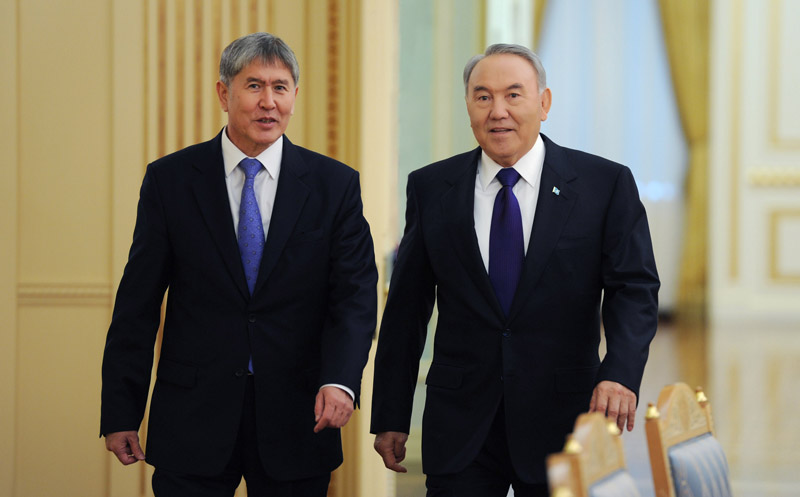
Kazakhstan Investment Part 2: Data Confirms Kazakhstan’s Status as Leading Global Investor
Publication: Eurasia Daily Monitor Volume: 10 Issue: 14
By:

*To read Part One, please click here.
According to the data released in December 2012 by the International Monetary Fund (IMF), Kazakhstan’s stock of cumulative foreign investment abroad was around $20 billion at the end of 2011. The top five destinations for Kazakhstan’s Outward Foreign Direct Investment (OFDI) were the Netherlands ($11.2 billion), which receives more than half the total, followed by the United Kingdom ($4 billion), the UK Virgin Islands ($707 million), the Russian Federation ($611 million), and the United States ($599 million) (https://cdis.imf.org/).
Although Kazakhstani FDI in China is presently under $100 million (tengrinews, July 24, 2012), these investment could increase significantly if Kazatomprom’s agreements to invest in China’s nuclear power industry bears fruit—especially in developing and marketing innovative small- and medium-sized reactors (World Nuclear Association Uranium and Nuclear Power in Kazakhstan, May 2012).
From having almost no OFDI during its first decade of independence, Kazakhstan has in recent years become one of the largest outward investors from the Commonwealth of Independent States (CIS) region as well as the leading source, by a wide margin, of OFDI of the five Central Asian countries. Kazakhstani companies are increasingly listing on the London Stock Exchange; the value of their international public offerings (IPOs) has been more than $14 billion since 2005 (British Embassy to Kazakhstan, Astana, January 2013).
Kazakhstan’s ODFI profile has grown steadily during the past decade, following the resurgence of Kazakhstan’s economy due to rising world energy prices and other developments. From 2001 to 2002, the ODFI stock increased from $42.6 million to $463.9 million. By 2007, that figure reached $3.2 billion and rose further to $7.8 billion by 2010. The total of Kazakhstan’s direct investments abroad at the end of 2011, $19.481 billion, placed the country among the 50 largest FDI senders worldwide. According to IMF data, Kazakhstan’s OFDI is growing by around ten percent each year.
The major sources of Kazakhstani OFDI are private companies (especially in banking, construction and tourism) and state-owned enterprises, including the National Oil Fund as well as public corporations like Kazmunaigaz (which invest in foreign energy assets). Most OFDI goes to energy, banking and construction projects, which are the business sectors most developed within Kazakhstan itself. Even the private exporters benefit from government support with public finances, investment guarantees and diplomatic lobbying. Kazakhstan has also established joint national funds with foreign countries (e.g., Kyrgyzstan, Tajikistan, Russia), which concentrate on funding massive infrastructure projects designed to develop Central Asia’s energy, transportation, natural resources and other sectors requiring a large and long-term funding commitment.
Kazakhstani firms invest abroad for the same reasons as other large companies—to increase their sales, lower their costs (through cheaper production inputs), and secure local resources (including skilled workers). Other benefits to Kazakhstan from its OFDI include generating profits, royalties and tax revenue; making Kazakhstani firms more competitive and efficient; raising domestic demand for skilled labor and other employment; diversifying the country’s exports and sources of income; developing Kazakhstani human capital; and elevating Kazakhstan’s global presence and influence. Through their presence in foreign markets, Kazakhstani firms can, like other foreign companies, help the host country acquire better goods, increase exports and jobs, acquire and apply new technologies, learn new operating techniques, as well as generate pressure on competitors to improve their own performance.
While Kazakhstan now has global investments, the main beneficiaries of its OFDI remain its neighboring Central Asian states, along with Georgia and Kazakhstan itself. In Western countries, which attract enormous volumes of FDI, Kazakhstan’s contributions tend to get lost in the crowd. Kazakhstani FDI in Russia can at best have a noticeable impact in a few places and sectors given the size of the Russian economy. But in certain Central Asian countries and Georgia, Kazakhstan’s share of total FDI can be considerably higher due to the smaller volume of competitive investment.
For many years, Kazakhstan was the leading source of FDI in neighboring Kyrgyzstan, whose lack of mineral wealth made it relative unattractive to foreign investors. Gold mining, sugar processing, a cement plant, highways and tourism attracted large Kazakhstani FDI. Kazakhstan’s direct investments to Kyrgyzstan amount to more than $1 billion in such sectors as banking, construction and energy. Almost 300 Kazakhstani firms operate in Kyrgyzstan, along with 100 enterprises with some Kazakhstani capital (Tengrinews, October 25, 2011). In 2011, the two countries established a joint investment fund worth €100 million ($135 million), that would focus initially on the construction of the Datka Kemin power transmission line as well as hydropower expansion and the banking sector (neurope.eu, July 3, 2011). The Datka Kemin line will allow Kyrgyzstan to transfer energy to Kazakhstan, helping end the latter’s dependence on energy transit via Uzbekistan.
Kazakhstani FDI in in Tajikistan has also been prominent. Kazakhstan’s investments have gone into Tajikistan’s banking sector, food industry, energy sector, non-ferrous metals, telecommunications and metals mining. A joint Kazakhstani-Tajikistani investment fund worth $100 million was established in 2010, with Kazakhstan providing $80 million. The joint fund’s main investment targets include electricity production, agriculture and mining.
The surge in Kazakhstan’s FDI in Georgia starting around 2005 made Kazakhstan the largest investor in that country by 2008, when Kazakhstani investment slowed due to the war and the global financial crisis. Kazakhstani FDI in Georgia soared following the rebound in oil prices, the 2003 Rose Revolution, and a very successful first official meeting of the newly elected Georgian President Mikheil Saakashvili with President Nazarbayev in 2005. By 2006, Kazakhstan was reportedly the single largest investor in Georgia, and by 2008 it was estimated that total investments reached $2 billion. Kazakhstani FDI is concentrated in the energy, transportation, communications, banking and tourism sectors (pm.kz/news, December 07, 2011).
Kazakhstan is already, by many accounts, the most significant economy in Central Asia. Its importance in international markets is now also growing, though remains relatively modest. Nevertheless, thanks to energetic domestic business investments abroad coupled with government encouragement, Kazakhstan has become one of the most important economic partners to many of its closest neighbors, a trend that is likely to continue.




